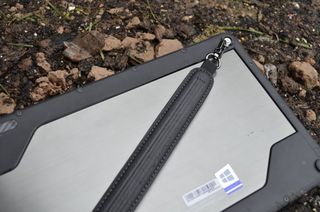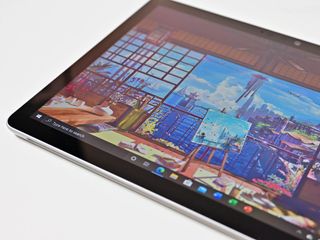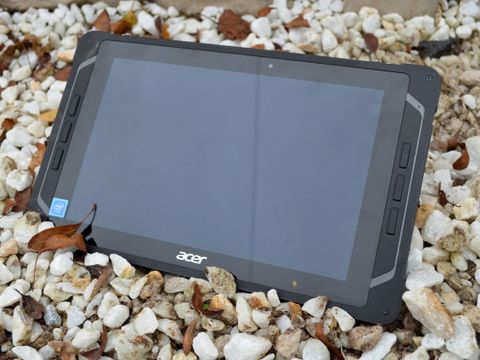I'm a bit rough when it comes to technology. If I don't put a device in a case, slap on a screen protector, and carry it in something durable, my kit doesn't last nearly as long as it should. So when I covered the Acer Enduro lineup of rugged devices earlier this year, I was immediately intrigued.
While I don't work in a warehouse or on a production line, which are better examples of what the Acer Enduro T1 is built for, I do use my tech in places that I wouldn't trust myself with a naked iPad or more fragile device. Acer sent me over an Enduro T1 for review, and I used it on the sidelines of American football practice, around the house, and during some toughness testing in my back yard.
Here's how the tough tablet stood up to my testing.

Bottom line: The Acer Enduro T1 is a tough Windows tablet built for warehouse workers, retail staff, and other working environments that can require rugged tech. It isn't as tough as more expensive rugged hardware, but it's tough enough to work outside without anxiety.
For
- MIL-STD-810G, IP54
- Excellent standby battery life
- Strong battery life during usage
- Panel bonded touch screen
- Supports several optional accessories
Against
- Weaker Celeron processor
- Slow to wake from sleep
- Windows tablet mode is poor
- Power button is inconsistent
- No LTE option
- No pen support
Acer Enduro T1 specs, features, and benchmarks
The Enduro T1 is a 10.1-inch rugged tablet that runs Windows 10. It meets MIL-STD-810G and IP54 standards, meaning it can withstand drops up to 122 cm (4 ft), sand and dust, and water. It's rated for extreme temperatures as well. It can handle temperatures as low as -32 degrees Celsius (-25.6 Fahrenheit) and up to 49 degrees Celsius (120.2 Fahrenheit).
On the software side of things, the tablet runs on Windows 10 Pro.
| Category | Spec |
|---|---|
| OS | Windows 10 Pro |
| Processor | Intel Celeron N3450 |
| RAM | 4GB LPDDR4 |
| Graphics | Intel HD Graphics 500 |
| Storage | 64GB eMMC |
| Display | 10.1 inches 1280x800 IPS 350 nits |
| Audio | Single speaker 3.5mm audio jack |
| Connectivity | Intel Wi-Fi 5 Bluetooth 4.2 NFC (optional) |
| Battery | 37Whr Up to 10 hours |
| Ports | microHDMI USB 3.2 Gen 1 US-C with DC-in Headphone jack microSD USB 2.0 |
| Dimensions | 7 x 11.4 x 0.5 inches (178mm x 290mm x 11.7mm) |
| Weight | From 1.98 pounds (0.9kg) |
| Price | $565 |
The ruggedness of the Enduro T1 is immediately noticeable. It has some heft to it, and that's in a welcome way that comes from tougher materials.
The Enduro T1 has a panel-bonded display that supports touch. It's a surprisingly nice display, considering its low resolution. It produces crisp images that I didn't expect from this type of device. The device's resolution is low (1280 x 800), but it's good enough for professional and fieldwork.


The tablet's display is optimized for use in various environments. There are three physical buttons on each side of the display, including buttons for power, volume, the Start Menu, and two programmable keys. You can use its touch screen with gloves. The screen responded well to touch while I wore construction gloves and rubber gardening gloves. Interestingly, it did not respond to softer acrylic winter gloves.
The Enduro T1 has a solid selection of ports. The tablet's right side has a micro HDMI port, USB 3.2 Gen 1 port, and a USB-C port. The device's left side has a USB 2.0 port, a microSD slot, and a headphone jack. The ports are grouped in threes, with each group having a cover that protects the ports from the elements.


The Enduro T1 has just a single speaker on the back of the device. It's not an excellent speaker, but it's enough to get the job done. You can watch how-to videos and other content without any issues. The speaker gets loud enough, but it's tinny.
I reviewed the tablet as a standalone device without a keyboard, but several accessories are available. On the tech side of things, you can get a folio keyboard that converts it into a 2-in-1. You can also get an optional barcode scanner. There are three different grips available: a hand strap, a handgrip, and a shoulder strap. The tablet has metal rings built-in for attaching straps.
One slightly irritating thing is that the hand strap attaches in a way that's much easier for right-handed people. I know it's nitpicking, but I like to hold my tablet in my left hand and use it with my right. It looks like you might be able to switch this with tools, but I didn't want to pry pieces off of my review unit and break out a torque screwdriver to flip a hand strap around.
Geekbench 5
Geekbench 5.0 (CPU) (Higher is better)
| Device | CPU | Single core | Multi core |
|---|---|---|---|
| Acer Enduro T1 | Celeron N3450 | 257 | 770 |
| Surface Go 2 | Core m3 | 847 | 1,609 |
| Surface Go | Pentium | 376 | 947 |
| Surface Pro X | SQ1 | 725 | 2,819 |
| Surface Laptop 3 13.5 | i5-1035G7 | 1,177 | 4,413 |
| Surface Laptop 2 | i5-8250U | 909 | 3,372 |
| Surface Pro 7 | i5-1035G4 | 1,191 | 4,441 |
| Surface Pro 6 | i7-8650U | 1,113 | 3,519 |
| Surface Pro 6 | i5-8250U | 904 | 3,440 |
SSD
CrystalDiskMark (Higher is better)
| Device | Read | Write |
|---|---|---|
| Acer Enduro T1 (eMMC) | 316 MB/s | 219 MB/s |
| Surface Go 2 (SSD) | 1,630 MB/s | 373 MB/s |
| Surface Go (SSD) | 1,185 MB/s | 133 MB/s |
| Surface Go (eMMC) | 260 MB/s | 145 MB/s |
| Surface 3 | 149 MB/s | 33 MB/s |
| Surface Pro X | 2,023 MB/s | 832 MB/s |
| Samsung Galaxy Book2 | 722 MB/s | 205 MB/s |
| HP Envy x2 | 513 MB/s | 197 MB/s |
| Surface Laptop 3 13.5 | 2,338 MB/s | 1,583 MB/s |
| Surface Laptop 3 15 | 2,028 MB/s | 806 MB/s |
| Surface Laptop 2 | 1,509 MB/s | 811 MB/s |
| Surface Laptop | 486 MB/s | 244 MB/s |
| Surface Pro 7 | 2,040 MB/s | 809 MB/s |
| Surface Pro 6 | 1,632 MB/s | 814 MB/s |
| Surface Pro 5 | 847MB/s | 801 MB/s |
| Surface Book | 1,018 MB/s | 967 MB/s |
| Dell XPS 13 2-in-1 7390 | 2,400 MB/s | 1,228 MB/s |
.
Tablet mode is still a letdown on Windows

It may sound strange, but I don't recommend using the Enduro T1 in Windows 10's Tablet Mode, even if you use it exclusively as a tablet. The frustrating reality is that Tablet Mode on Windows 10 feels like abandonware. Microsoft made Tablet Mode years ago and either forgot about it or has decided to wait until it improves Windows 10 next year. But that doesn't mean that the Enduro T1 is a bad tablet; let me explain.


I wrote about Tablet Mode back in 2018, as did our executive editor Daniel Rubino. Our complaints appear to have fallen on deaf ears, along with the complaints of many other Windows 10 users. Tablet Mode is clunky, handles multitasking poorly, and the Enduro T1 even seems to run slower while using it.
All of that being said, the Enduro T1 is a fine tablet, as long as you use Windows 10 outside of tablet mode. If you set the Start Menu to open in full screen and just use the tablet on the Desktop Mode of Windows 10, you should be fine. It's not as elegant or smooth as iOS, but it's functional enough.
To clarify, I don't think this is Acer's fault. Microsoft hasn't invested in Windows 10's Tablet Mode and all Windows devices, including Microsoft's own Surface devices, suffer for it.
Using the Acer Enduro T1

Specs and durability claims are nice, but real-world usage is what's most important, at least to me. The Enduro T1 kicked things off with a solid first impression as I unboxed it and noticed its heft. The tablet just feels rugged. There's no creak to it. It has a healthy weight but isn't cumbersome. I felt comfortable using it in a variety of settings from day one.
The Enduro T1 isn't built to be indestructible, so don't take that away from this review. Some tablets are even tougher, such as the Panasonic TOUGHBOOK A3, but that device is significantly more expensive and built for first-line workers. In contrast, the Enduro T1 is built for warehouse workers, retail use, and professional settings that can put your tablet in danger.
My first few real-world tests were on the sidelines of an American football field. I'm considering buying an Enduro T1 for coaching because I can use it on the field without working about if someone bumps into me, causing me to drop it, or if it starts raining. England isn't likely to be colder than 32 degrees Celsius or over 49 degrees Celsius, but it gets chilly here. It's nice to know that the tablet can handle our weather, whether it be rain, snow, heat, or cold.

To test the device against a more likely scenario for people who will actually buy it, I took the Enduro T1 into my back yard and ran it through some toughness tests. I covered it in kiln-dried sand, poured water over it, and dropped it onto concrete (more on that in a bit), and it held up well. The worst I can say is that a little water got through the port covers, but the water didn't seem to get into or damage the actual ports.
Dropping the tablet was the last test that I did because it would hinder the rest of my review if it broke the tablet. I went out and dropped the tablet from a variety of angles, including directly onto its screen and straight onto its corner, and I can't see any damage. The Enduro T1 is rated for drops up to 122cm (roughly 4 ft), so I didn't go crazy and throw the thing off a roof, but my drop tests were onto solid concrete.
On the software side of things, the Celeron processor won't win any races. It's functional but certainly isn't swift. It handles apps fine and should be able to handle normal workloads based on my testing. My only real complaint was that the device takes a few seconds to wake up from sleep. I didn't expect it to be as quick as a Windows 10 on ARM device or Microsoft's newer Surface hardware, but the Enduro T1 can take several seconds to wake after you press the power button. Sometimes, I have to press the power button multiple times, which is annoying.
Finally, the Enduro T1 is a battery beast, especially considering this model only has a 37Whr battery. Testing battery life is always a bit tricky, but this tablet earned high marks in every way that I could measure it. In everyday testing, I just never had to worry about battery life. Whether I was using Office, watching videos, or browsing the web, the battery just kept chugging.
To try to get some sort of finite measurement in "real-world usage," I cranked the tablet to its maximum brightness setting and streamed videos for hours on end over Wi-Fi. After four hours, the Enduro T1's battery was at 49 percent, easily on pace for more than eight hours on a charge. I think it's reasonable to assume that with lower screen brightness and more standard usage, that the Enduro T1 could hit Acer's claims of up to 10 hours of battery life.
Running a battery report on the device yielded an average of 7 hours and 58 minutes from a full charge, which lines up perfectly with my testing.
I was also blown away by the standby battery life on the tablet. I fully charged the device and left it for over a day, and it only dropped to 98 percent.
Let's talk about the competition

The rugged device market is generally dominated by Panasonic. They make great devices, but it's always great to see some competition. The Enduro T1 isn't as tough as more expensive devices, such as Dell's rugged Latitude lineup but it is significantly cheaper, which makes a big difference if you're buying devices in bulk.
Some might not love using a Windows 10 tablet in 2020. If that's the case, Acer also has an Enduro T1 that runs Android, though it only has an 8-inch screen.
While I do like the Enduro T1, some competing devices are worth a look. You can grab a Surface Go 2 and put it inside a rugged case. The UAG Metropolis and several other rugged cases also meet the MIL-STD 810G standard. There are even waterproof cases for the Surface Go starting at $100. That's a lot for a case, but the Surface Go's total starting price with a rugged case is lower than the price of the Enduro T1.
With a proper rugged case and a Surface Go 2, you get a better processor (see UserBenchmark comparison), pen support, a kickstand, and an option for 4G-LTE.
Choosing between the Enduro T1 and a setup like the Surface Go 2 with a rugged case will depend on why you need a rugged device. The Surface Go 2 setup is more versatile in some ways, thanks to options for a pen and LTE, but the Enduro T1 has more ports. The Enduro T1 is built to be rugged from the inside out. No matter what case you get for the Surface Go 2, it won't add all of the same protection, such as protection from extreme temperatures like the Enduro T1 has. Honestly, both are good options, but picking one over the other depends on your specific needs.
Acer Enduro T1: A Windows tablet that's tough enough for the real world

Who it's for
- If you're a factory worker
- If you're a warehouse worker
- If you're in lower risk construction
- Anyone who needs a rugged Windows tablet
Who it isn't for
- Don't buy if you don't need the durability — your money would get you more from other devices
- Don't buy if you already have a device like the Surface Go and would be happy with a rugged case
Overall, I think the Acer Enduro T1 is a solid tablet, both in usability and rugged design. If you're shopping for a company, or just for yourself, for a tablet that can withstand wear and tear, the Enduro T1 is worth a look.
The rigged and rugged body of the Enduro T1 can stand up to wear and tear better than average tablets, even if you grab a protective case for a normal tablet. Things like the panel-bonded glass, stiff body, and built-in ruggedization make the Enduro T1 stand out. It's a tablet designed to be tough rather than a tablet that was made tough after the fact. As a result, the device feels rugged inside and out.
While I didn't review the folio keyboard or barcode scanner, they're nice options that expand the tablet's versatility. Having a keyboard for the device lets you enter data, draft emails, and use the device to more of its potential.

A rugged Windows tablet
The Acer Enduro T1 is a tough Windows tablet built for warehouse workers, retail staff, and other working environments that can require rugged tech. It isn't as tough as more expensive rugged hardware, but it's tough enough to work outside without anxiety.

Sean Endicott brings nearly a decade of experience covering Microsoft and Windows news to Windows Central. He joined our team in 2017 as an app reviewer and now heads up our day-to-day news coverage. If you have a news tip or an app to review, hit him up at sean.endicott@futurenet.com.
